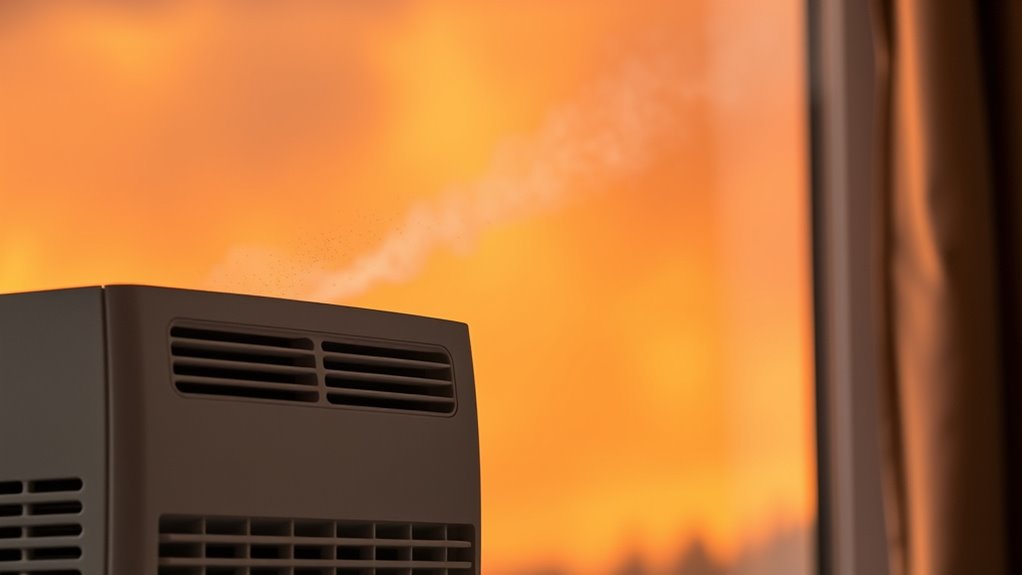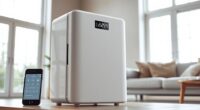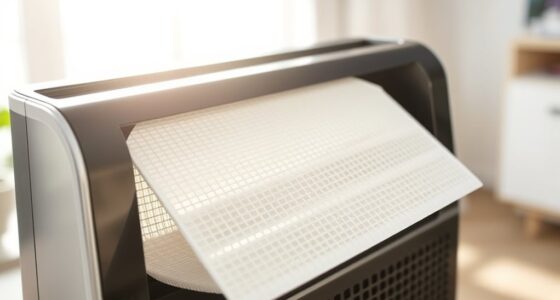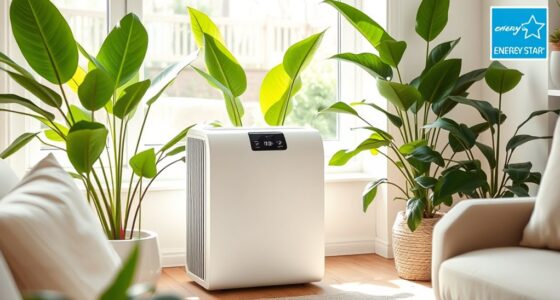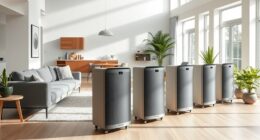During wildfire season, HEPA filters are vital because they capture tiny harmful particles like PM2.5 that can reach deep into your lungs, causing irritation and increasing health risks. By trapping smoke and pollutants indoors, HEPA filters help you breathe easier and protect your respiratory health. Proper filtration can make a big difference in maintaining lung health during smoky days. If you’re curious about how to maximize your home’s protection, there’s more to learn about effective indoor air strategies.
Key Takeaways
- HEPA filters effectively trap wildfire smoke particles, preventing them from entering indoor air and protecting lung health.
- Fine particulate matter (PM2.5) can penetrate deep into lungs, but HEPA filtration reduces exposure significantly.
- Using HEPA filters indoors during wildfires minimizes respiratory irritation and helps manage pre-existing lung conditions.
- Proper sealing combined with HEPA filtration prevents smoke infiltration, maintaining cleaner indoor air quality.
- Continuous use and regular filter replacement ensure optimal filtration, providing ongoing lung protection during wildfire seasons.
Understanding Wildfire Smoke and Its Health Risks
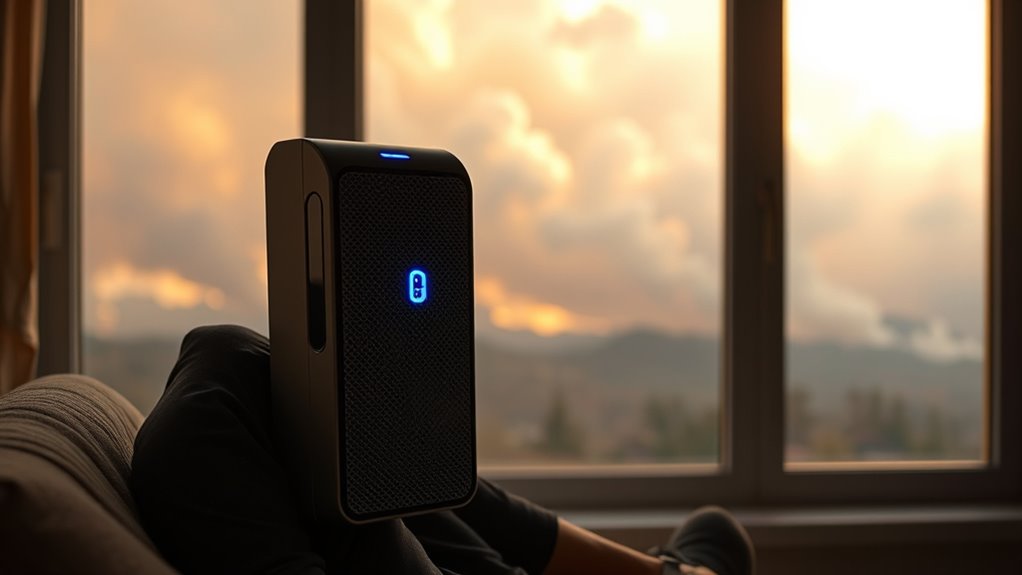
Have you ever wondered what makes wildfire smoke so harmful to your lungs? Wildfire smoke is a complex mixture of tiny particles and gases released when vegetation burns. These microscopic particles, called particulate matter (PM), can penetrate deep into your respiratory system, irritating your lungs and airways. The harmful components also include carbon monoxide, volatile organic compounds, and other toxins that compromise your respiratory health. Breathing in wildfire smoke can cause coughing, shortness of breath, and worsen pre-existing conditions like asthma or COPD. The fine particles are especially dangerous because they bypass your body’s natural defenses, leading to inflammation and reduced lung function. Protecting your respiratory health during wildfire season means understanding these risks and taking steps to limit your exposure. Filtration systems such as HEPA filters can help reduce indoor air pollution, providing an additional layer of protection for your lungs during smoky conditions.
The Science Behind HEPA Filtration Technology
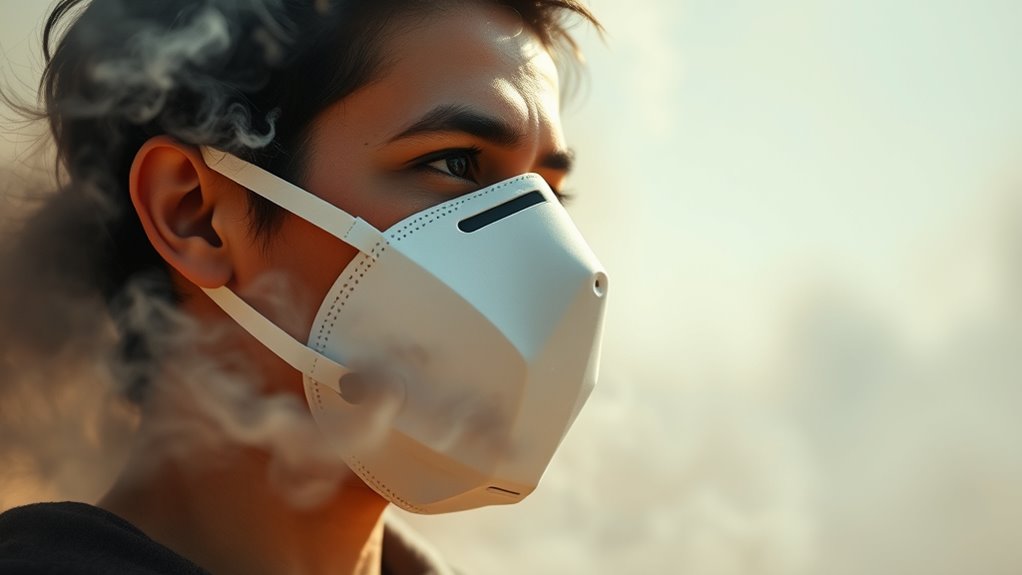
When it comes to reducing exposure to wildfire smoke and its harmful particles, understanding how air filtration works can make a significant difference. HEPA filters rely on specialized filter media made of dense fibers that trap particles through particle adhesion. As air passes through, tiny particles in the smoke cling to the fibers due to electrostatic forces and physical contact. This process effectively removes a wide range of airborne contaminants, including fine particulate matter. The filter media’s design maximizes surface area, increasing the chances for particles to stick. With this technology, HEPA filters capture an impressive amount of harmful particles before they can reach your lungs, providing essential protection during wildfire season. Knowing this science helps you appreciate why proper filtration is so crucial for lung health.
How HEPA Filters Capture Tiny Particles

HEPA filters capture tiny particles through a combination of three main mechanisms: interception, impaction, and diffusion. Particle size plays a vital role in how effectively these filters work, as smaller particles are harder to trap. Interception occurs when particles follow airflow lines but come close enough to a fiber to be caught. Impaction happens when larger particles collide directly with fibers due to their inertia. Diffusion is key for the tiniest particles, which move randomly and bump into fibers more often. These mechanisms work together to improve filtration efficiency across a range of particle sizes, including smoke and wildfire ash. Additionally, Jeep tuning modifications can optimize air intake systems, further enhancing filtration performance. By effectively capturing even the smallest particles, HEPA filters help keep the air you breathe cleaner and safer during wildfire season.
Benefits of Using HEPA Filters During Wildfire Events
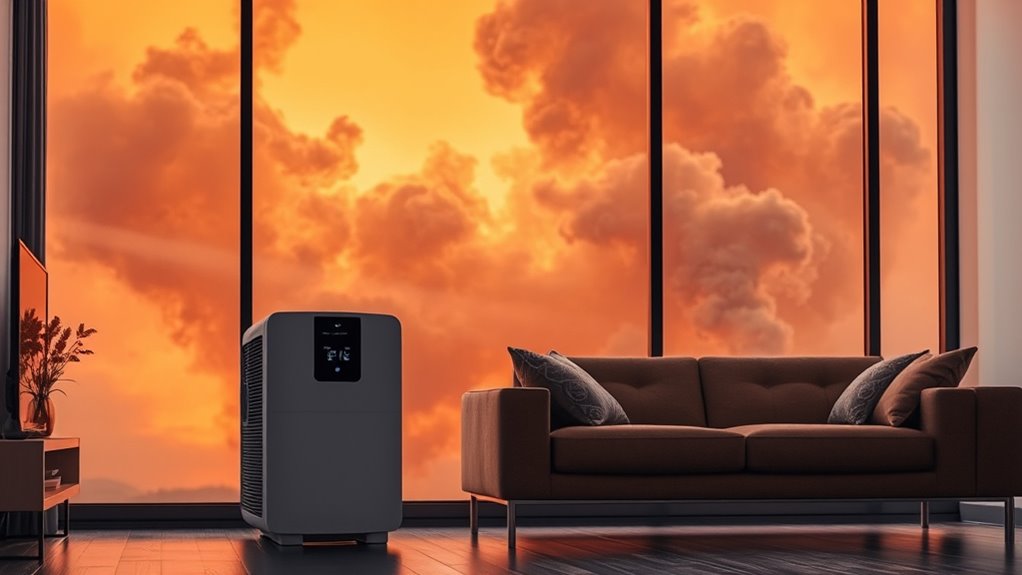
During wildfire events, using HEPA filters substantially reduces your exposure to harmful airborne particles. This improves indoor air quality, helping you breathe easier and protect your respiratory health. HEPA filters efficiently trap smoke, ash, and pollutants that can irritate your lungs, preventing them from circulating indoors. To highlight the benefits, consider this comparison:
| Benefit | Explanation | Result |
|---|---|---|
| Cleaner Indoor Air | Removes tiny particles like smoke and ash | Fewer respiratory irritations |
| Improved Respiratory Health | Reduces inhalation of harmful pollutants | Better lung function |
| Peace of Mind | Protects you during wildfire seasons | Confidence in your home’s safety |
Using HEPA filters during wildfires keeps your indoor environment safer, supporting healthier lungs and better overall well-being. Additionally, choosing a safety-conscious filtration system can maximize protection during these times.
Choosing the Right Filtration System for Your Home

Choosing the right filtration system for your home depends on evaluating your specific air quality needs and the types of pollutants you want to target. If you’re concerned about wildfire smoke, look for HEPA filters that effectively capture fine particles and allergens. Regular HEPA maintenance is essential to keep your system working efficiently; this includes timely filter replacement. Neglecting filter replacement can reduce filtration effectiveness and strain your system, leading to decreased indoor air quality. Additionally, selecting a filtration system with proper room coverage size ensures that the air purifier can adequately service your space. Consider the size of your space and the noise level of the unit, ensuring it fits your lifestyle. By selecting a system suited to your needs and maintaining it properly, you’ll improve indoor air quality and better protect your lungs during wildfire season.
Tips for Maximizing Indoor Air Quality During Wildfires
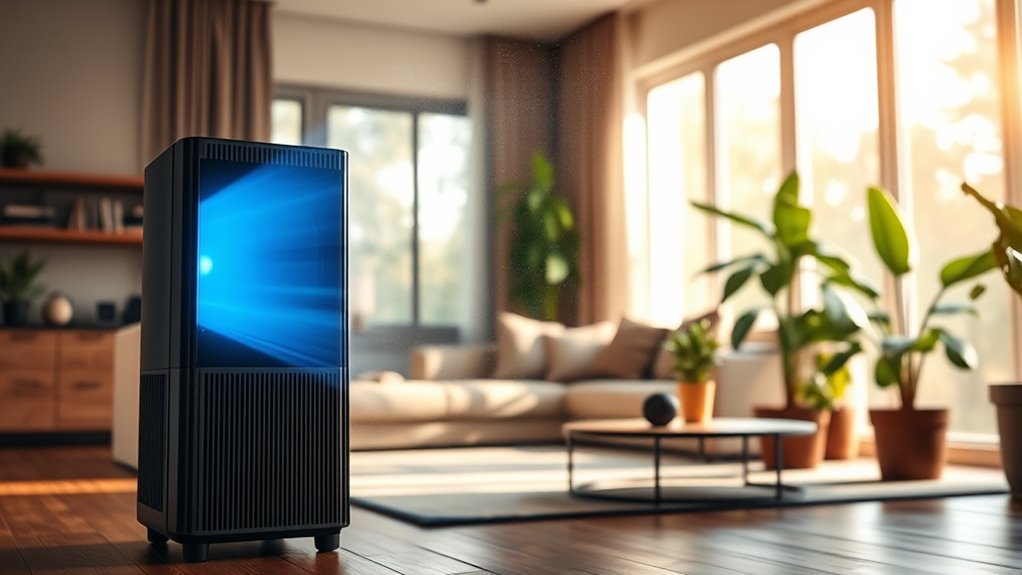
To keep indoor air clean during wildfires, start by sealing windows and doors tightly to prevent smoke from sneaking inside. Use air purifiers correctly, placing them in high-traffic areas and ensuring they have HEPA filters. These simple steps can make a big difference in protecting your lung health when wildfire smoke fills the air. Additionally, understanding the importance of air filtration technology can help you choose the most effective solutions to improve indoor air quality.
Seal Windows and Doors
Sealing your windows and doors is a crucial step in protecting your indoor air quality during wildfires. Proper window insulation prevents smoke from seeping inside, maintaining cleaner air. Check for gaps around your window frames and use weatherstripping or caulk to seal them tightly. Door sealing is equally important; install door sweeps or draft stoppers to block smoke infiltration. These measures create a strong barrier against outdoor pollutants, reducing your exposure to harmful wildfire smoke. Additionally, water filtration systems can further improve indoor air quality by removing microscopic particles from the air you breathe. Ensuring your windows and doors are well-sealed helps maintain a healthier indoor environment, especially when combined with other filtration strategies. Taking these simple steps can notably improve your indoor air quality and safeguard your lungs during wildfire season.
Use Air Purifiers Properly
Once your windows and doors are well-sealed, the next step is to guarantee your indoor air remains clean during wildfire events by using air purifiers effectively. Place your purifier in high-traffic areas or where you spend most of your time. Regularly check and follow your air purifier maintenance and filter replacement schedules to ensure maximum performance. Keep a close eye on filter indicators and replace filters promptly to maintain strong filtration. Remember, a well-maintained purifier can considerably reduce harmful particles, protecting your lungs.
| Air Quality & Comfort | Emotional Impact |
|---|---|
| Fresh, clean air | Peace of mind during smoky days |
| Clear breathing | Confidence in your home environment |
| Healthy lungs | Relief knowing you’re protected |
Frequently Asked Questions
Can HEPA Filters Remove Gases and Chemical Pollutants From Wildfire Smoke?
HEPA filters excel at trapping tiny particles but don’t effectively remove gases and chemical pollutants from wildfire smoke. For gas removal and chemical filtration, look for air purifiers with activated carbon filters, which absorb harmful chemicals and volatile organic compounds. You need this combination to protect your lungs during wildfire season, as HEPA alone can’t fully filter out the dangerous gases released by fires.
How Often Should HEPA Filters Be Replaced During Wildfire Season?
Filter lifespan and replacement frequency are key during wildfire season. You should replace HEPA filters every 6 to 12 months, or sooner if they become visibly dirty or the airflow decreases. Regularly check your filters, as clogged or saturated filters lose their effectiveness. Prompt replacements guarantee you’re breathing clean air, protecting your lungs and maintaining filter performance. Staying attentive to these details maximizes the filter’s ability to filter harmful particles effectively.
Are Portable HEPA Air Purifiers Effective in Large Open Spaces?
Portable HEPA air purifiers can be effective in large open spaces if they address ventilation challenges and optimize airflow. You need units with sufficient coverage and high CADR ratings to circulate and filter air properly. Position them strategically to improve airflow, and consider additional ventilation options if airflow is limited. Proper placement and choosing the right purifier size help guarantee cleaner air and better protection during wildfire season.
Do HEPA Filters Eliminate Odors Caused by Wildfire Smoke?
HEPA filters primarily remove particles like smoke and soot, but they don’t effectively eliminate odors caused by wildfire smoke. While they can improve air quality by reducing smoke masking particles, odors often require activated carbon or charcoal filters for odor removal. If you want to tackle smoke masking and odors during wildfire season, look for air purifiers that combine HEPA with activated carbon filters for the best results.
What Maintenance Is Required to Keep HEPA Filters Functioning Effectively?
To keep your HEPA filters working effectively, you need to follow proper maintenance. You should regularly check the filter for dirt and debris, and replace it as recommended by the manufacturer—usually every 6 to 12 months. Additionally, clean the surrounding area and follow cleaning procedures for your unit to prevent dust buildup. This guarantees peak filtration, helping you breathe cleaner air during wildfire season.
Conclusion
By using HEPA filters during wildfire season, you’re actively protecting your lungs from harmful smoke particles. Imagine a family in California, who installed a HEPA system just before a fierce wildfire outbreak—months later, they experienced fewer respiratory issues than neighbors without filtration. Investing in the right filtration system isn’t just about cleaner air; it’s about safeguarding your health. Don’t wait—take action now to breathe easier and stay safe during wildfire events.
